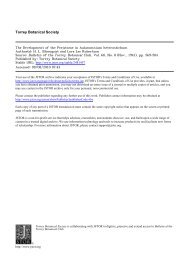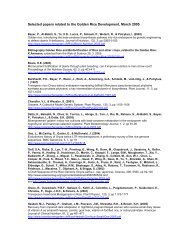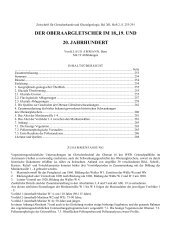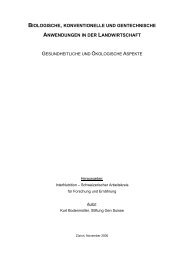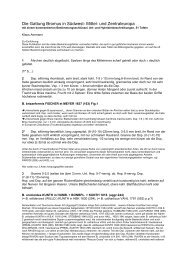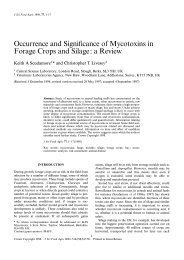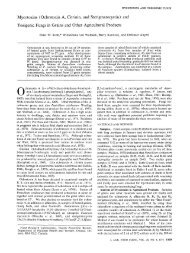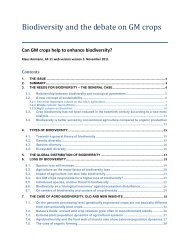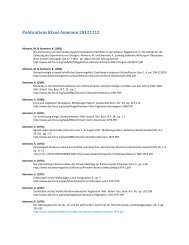Genetic engineering of plants to enhance resistance to fungal ...
Genetic engineering of plants to enhance resistance to fungal ...
Genetic engineering of plants to enhance resistance to fungal ...
You also want an ePaper? Increase the reach of your titles
YUMPU automatically turns print PDFs into web optimized ePapers that Google loves.
Punja: genetic <strong>engineering</strong> / <strong>fungal</strong> disease <strong>resistance</strong> 217<br />
que les introductions d’un seul transgène pour lutter contre les maladies. L’emploi de promoteurs spécifiques à un tissu<br />
ou inductibles par les agents pathogènes et le génie appliqué à l’expression de gènes de résistance, de peptides<br />
synthétiques antimicrobiens et de molécules inductrices qui stimulent les réponses de défense ont le potentiel pour<br />
fournir commercialement, dans un futur pas si lointain, un moyen pratique pour résister à un large spectre de maladies.<br />
Les problèmes et les défis qui devront être surmontés avant d’arriver à une utilisation à grande échelle de ces plantes<br />
transgéniques sont mis en évidence.<br />
Mots clés : protéines antifongiques, peptides antimicrobiens, biotechnologie, éliciteurs, réaction d’hypersensibilité,<br />
protéines reliées à la pathogenèse, phy<strong>to</strong>alexines, gènes de résistance, plantes transgéniques.<br />
Introduction<br />
<strong>engineering</strong> / <strong>fungal</strong> disease <strong>resistance</strong><br />
One <strong>of</strong> the challenges facing breeders during the development<br />
<strong>of</strong> improved crop cultivars for agricultural use is the<br />
incorporation <strong>of</strong> <strong>resistance</strong> <strong>to</strong> diseases. Since domestication<br />
<strong>of</strong> <strong>plants</strong> for human use began, diseases have caused major<br />
yield losses and have impacted the well-being <strong>of</strong> humans<br />
worldwide (Agrios 1997). The incorporation <strong>of</strong> disease <strong>resistance</strong><br />
genes in<strong>to</strong> <strong>plants</strong> has been successfully achieved<br />
using conventional breeding methods, which involve selection<br />
and evaluation <strong>of</strong> large progeny populations derived<br />
from crosses made between resistant and susceptible parents<br />
and subsequent screening under disease conducive conditions.<br />
Virtually all agricultural crop cultivars in use <strong>to</strong>day<br />
have some form <strong>of</strong> genetic <strong>resistance</strong> incorporated, generally<br />
against a number <strong>of</strong> diseases. This may involve single<br />
or multiple genes that are characterized as having recessive<br />
or dominant effects (Crute and Pink 1996). Without the incorporation<br />
<strong>of</strong> these <strong>resistance</strong> genes, crop productivity and<br />
yield would be substantially reduced (Agrios 1997).<br />
With the beginning <strong>of</strong> the molecular era <strong>of</strong> plant biology<br />
in the early 1980’s, a major area <strong>of</strong> research has been <strong>to</strong><br />
identify, clone, and characterize various genes involved in<br />
disease <strong>resistance</strong>. As a result, many intriguing mechanisms,<br />
which <strong>plants</strong> have evolved <strong>to</strong> respond <strong>to</strong> pathogen<br />
infection, have been identified over the past 10 years, and<br />
remarkable progress has been made <strong>to</strong>ward elucidating the<br />
multitude <strong>of</strong> genes that are involved in these responses. The<br />
identification <strong>of</strong> these genes has made it possible <strong>to</strong> subsequently<br />
evaluate their specific roles and importance in disease<br />
response pathways using transgenic <strong>plants</strong> developed<br />
with genetic <strong>engineering</strong> techniques (Fig. 1).<br />
In this paper, I will review advances made in utilizing a<br />
broad range <strong>of</strong> cloned genes (from both plant and nonplant<br />
sources) <strong>to</strong> <strong>enhance</strong> disease <strong>resistance</strong> against <strong>fungal</strong> pathogens<br />
in transgenic <strong>plants</strong> and address future challenges and<br />
prospects. Several other reviews on the subject <strong>of</strong> genetic<br />
<strong>engineering</strong> for <strong>fungal</strong> disease <strong>resistance</strong> provide related information<br />
on this <strong>to</strong>pic (Shah 1997; Swords et al. 1997;<br />
Bushnell et al. 1998; Evans and Greenland 1998; Honée<br />
1999; Melchers and Stuiver 2000; Rommens and Kishore<br />
2000). The approaches that have been taken by researchers<br />
can be grouped in<strong>to</strong> five general categories (see Table 1):<br />
(1) The expression <strong>of</strong> gene products that are directly <strong>to</strong>xic<br />
<strong>to</strong> pathogens or that reduce their growth. These include<br />
pathogenesis-related proteins (PR proteins) such as<br />
hydrolytic enzymes (chitinases, glucanases), anti<strong>fungal</strong><br />
proteins (osmotin- and thaumatin-like), antimicrobial<br />
peptides (thionins, defensins, lectin), ribosomeinactivating<br />
proteins (RIP), and phy<strong>to</strong>alexins.<br />
(2) The expression <strong>of</strong> gene products Punja: that destroy geneticor neutralize<br />
a component <strong>of</strong> the pathogen arsenal such as<br />
polygalacturonase, oxalic acid, and lipase.<br />
(3) The expression <strong>of</strong> gene products that can potentially<br />
<strong>enhance</strong> the structural defenses in the plant. These include<br />
elevated levels <strong>of</strong> peroxidase and lignin.<br />
(4) The expression <strong>of</strong> gene products releasing signals that<br />
can regulate plant defenses. This includes the production<br />
<strong>of</strong> specific elici<strong>to</strong>rs, hydrogen peroxide (H 2 O 2 ),<br />
salicylic acid (SA), and ethylene (C 2 H 4 ).<br />
(5) The expression <strong>of</strong> <strong>resistance</strong> gene (R) products involved<br />
in the hypersensitive response (HR) and in interactions<br />
with avirulence (Avr) fac<strong>to</strong>rs.<br />
The selection <strong>of</strong> genes <strong>to</strong> genetically engineer in<strong>to</strong> <strong>plants</strong><br />
<strong>to</strong> protect against <strong>fungal</strong> diseases has been based, in part, on<br />
evaluation <strong>of</strong> the <strong>to</strong>xicity <strong>of</strong> the gene product <strong>to</strong> <strong>fungal</strong><br />
growth or development in vitro, and <strong>to</strong> the prominence <strong>of</strong><br />
the particular gene(s) in a disease <strong>resistance</strong> response pathway.<br />
Many gene products belong <strong>to</strong> the group <strong>of</strong> PR proteins<br />
(Neuhaus 1999; Van Loon and Van Strien 1999), while<br />
others are involved in phy<strong>to</strong>alexin biosynthetic pathways<br />
and in enhancing plant structural defenses. Although some<br />
<strong>of</strong> these gene products may normally be expressed relatively<br />
late in the response pathway, e.g. after 48 h, the rationale<br />
for developing transgenic <strong>plants</strong> was <strong>to</strong> achieve early<br />
and high expression (overexpression) <strong>of</strong> these proteins, usually<br />
constitutively throughout most <strong>of</strong> the plant. In other instances,<br />
<strong>enhance</strong>d levels <strong>of</strong> protein expression were<br />
reasoned <strong>to</strong> provide a greater inhibi<strong>to</strong>ry effect on <strong>fungal</strong> development<br />
than lower naturally occurring or induced levels<br />
in the plant. Other genes were selected in genetic <strong>engineering</strong><br />
efforts for their ability <strong>to</strong> induce an array <strong>of</strong> naturally<br />
occurring defense mechanisms in the plant. More recently,<br />
the cloning <strong>of</strong> R genes has precipitated interest in utilizing<br />
these genes <strong>to</strong> provide broad-spectrum disease <strong>resistance</strong>.<br />
Some genetic <strong>engineering</strong> approaches have been based on<br />
novel approaches <strong>of</strong> introducing genes from doublestranded<br />
RNA entities from viruses found in fungi (Clausen<br />
et al. 2000) and genes <strong>of</strong> lysozymes cloned from human tissues<br />
(Nakajima et al. 1997; Takaichi and Oeda 2000) and<br />
from a range <strong>of</strong> microbes (Lori<strong>to</strong> and Scala 1999).<br />
Hydrolytic enzymes<br />
The most widely used approach has been <strong>to</strong> overexpress<br />
chitinases and glucanases, which belong <strong>to</strong> the group <strong>of</strong> PR<br />
proteins (Neuhaus 1999) and have been shown <strong>to</strong> exhibit<br />
anti<strong>fungal</strong> activity in vitro (Boller 1993; Yun et al. 1997).<br />
Since chitins and glucans comprise major components <strong>of</strong>



